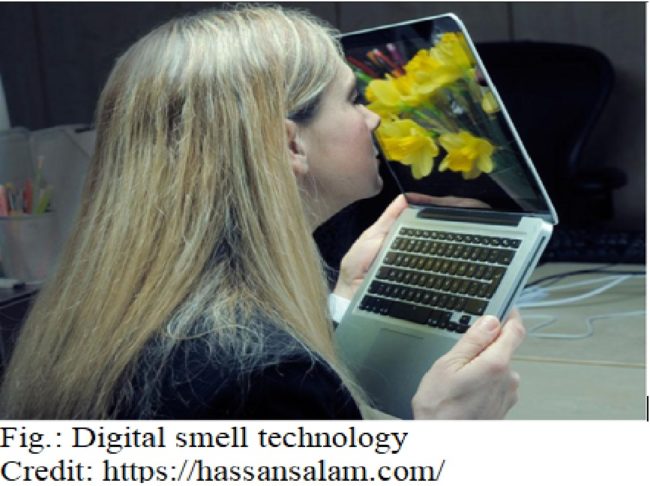Senses and sensors
Sensory receptors eyes, ears, skin, nostrils, and tongue etc. for seeing, listening, smell and taste make human life meaningful and enjoyable. Along with other senses, smell is an important sense which not only make us attentive to any danger like gas leak, fire or rotten food but is also closely linked to parts of the brain that process and influence emotion and memory function. Further, Smell has been an integral part of evolution and survival of humans and animals as it enables them to track food and water, find a mate and even communicate. However, we generally take our sense of smell in our day-to-day lives for granted, and rely more on our eyes and ears. With the electronic devices taking over human surroundings, life and working, not only natural sensing organs are being replaced with electronic sensors but senses are also being digitized. In this direction, electronic devices while in use producing digital aroma are catching very fast. Electronic screens with frequently changing pleasant screens outlays and colours have already been integrated into electronic devices. Softwares are taking care of all the required design, corrections and requirements while using the smart electronic devices. Modern electronic devices are already fulfilling the desired outcomes in terms of seeing and listening.
Above all, a good fragrance/smell/aroma around us plays a central role in our perception and will always create a soothing effect on our wellbeing and working as olfactory system located in our brain will effects emotions, memory, and creativity. Recently, fragrances are being added by companies to many products such as soap, cigarettes, washing powder etc. in order to make these feel good by affecting the memory and emotion parts of the brain. Such an aroma is generally being created with the use of chemical aromatics, essential oils, and botanical extracts. Perfume/scent houses around the world will always market their products as the latest and greatest sources of new smell. Entire perfume/scent industries exist as the human have placed such a huge importance on the smell and the fragrance industry is now bigger than ever. But the use of these all modes of creating smell or aroma are sometimes not very beneficial to human beings and may produce unwanted health effects or hazards.
Digital smell technology
The technology has so far targeted mainly our sense of sight and sound and there were the times when it was said that smell is almost impossible to be conveyed digitally. But this notion is all expected to change due to use of the Internet of Senses (IoS). Until now, online communication involved only two senses, sense of sight & a sense of hearing. Soon, it will involve the third sense, the sense of smell using a digital nose. Digital smell technology has emerged as the main application of e-nose. With digital scent technology, it will be possible to sense, transmit & receive smell through the internet. To further enhance the virtual reality experience with the technology another flavor is to be added to it which will target senses of nose (smell) and tongue (taste). Presently, digital smell technology has become the buzz word as the digital smell/aroma technology will make it feasible to have desired or exotic smell in our surroundings thus making our working with electronics devices more enjoyable. The application area of virtual reality is vast and in the times to come it will be possible to smell the product before buying them online. Various innovative start-ups are pioneering new approaches towards digital scent technology. The digital smell technology involves different scientific disciplines, including organic chemistry, silicon engineering, machine learning, data science, photonics, and software engineering. Many developments are being taking place in this exciting technology and some of them are mentioned as:
- A France based digital scent technology start-up “Aryballe” uses tiny proteins called peptides by grafting onto silicon wafers that react to the gas molecules associated with different smells. The various digital signatures are then have been decoded using machine learning and are expressed in the expressions that humans use to describe smells.
- A California based American company “Aromyx” working of digital smell technology based make use of the same sensing receptors that are found in the human nose and tongue to identify different smells.
- Researchers of a virtual reality company “All These Worlds” based in California (USA), have also developed a wireless-enabled scent collar that releases targeted scents for virtual reality simulations.
- Another California (USA) based “Digiscents Inc” company has developed the iSmell personal scent synthesizer. This small device connects to personal computer via serial port and has its own driver. Making use of the iSmell, the smelling screen can generate a localized smell distribution on a two-dimensional display screen. The produced smell distribution feels just like that a smell source had been placed on the screen which leads the user to perceive the smell as emanating from a particular region of the screen.
- A device called “The Aroma Shooter” developed by Japanese start-up “Aromajoin”, making use of solid-state materials can deliver split-second volleys of over 400 different scents. The technology is now being used to create soothing aroma environment in major departmental stores and also to improve virtual-reality applications using smell signage.
- Another Japanese start-up has also developed a device “the Scentee Machina”, that can connect to a smartphone app and diffuse different fragrances according to the user’s mood and the time of day.
Producing smell digitally
Experiments conducted recently by scientists and engineers at different places suggest that it may be possible to develop “digital smell” technology capable of conveying smells as well as sights and sounds. Digital smell technology is part of a whole, integrated virtual reality or augmented reality. The working of digital smell technology includes the continuously feeding of smells from vaporizing gel pellets into four air streams one in each corner of the screen. These air streams are delivered by fans parallel to the screen surface and varying the strength and direction will spread the smell to any given spot on the screen. A smell is generally indexed along two parameters i.e., its chemical makeup and its place in the smell spectrum. Then the smell is digitized into a small file and this digital scent file is attached to enhanced web content. The smell synthesizer is the device used to generate the smells using a computer. Presently, various types of smell synthesizers have been available in the market. The iSmell personal scent synthesizer developed by DigiScents Inc. (USA) is a small peripheral device, about the size of a personal computer speaker that can be connected to a computer through a Universal Serial Bus (USB) port and powered using any ordinary electrical outlet. The iSmell device will read a digital smell file then create a smell from a palette of 128 chemicals stored in a cartridge and then blow it into the air with the help of a small fan. The cartridge may contain chemicals like natural oils or synthetic fragrances that will be activated by either heat or air pressure when to send a smell signal from computer. The device works on using the consumable cartridges which are replaced similar to the way ink cartridges are replaced in ink jet printers.
Applications:
Rapidly emerging digital smell technologies well supported with virtual technology and artificial intelligence will support a variety of uses for improved human life, work outcome, product quality, in different areas as food, auto maintenance, health care, and the environment. Applications of digital smell technology are growing in different fields such as:
- Enhancing products’ appeal to consumers
- Send scented email
- Watch scented DVD’s
- Play scented video games
- Selecting a desired perfume from the website of beauty products
- Selecting and ordering of food items as per desired aroma from the sale in the online stores
- Enabling to share the aroma of a meal just prepared with others
- Faster and cheaper quality control
- Enabling the smart home
- Calibrating regional tastes
- Predictive maintenance
- Early diagnosis and prevention in health care
- Reducing environmental impacts
- Digital smell technology can also increase the effectiveness of recycling initiatives
- Application in mental health treatment



